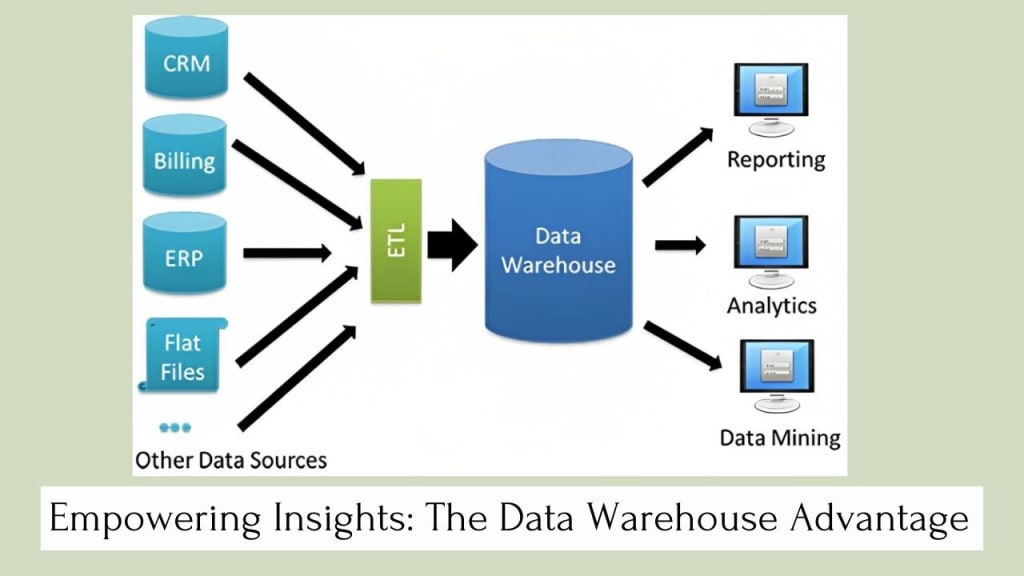Empowering Insights: The Data Warehouse Advantage
In today's data-driven world, organizations face a significant challenge in efficiently managing and utilizing the vast amount of information generated through various systems and processes.

In today's data-driven world, organizations face a significant challenge in efficiently managing and utilizing the vast amount of information generated through various systems and processes. This challenge is further amplified by the increasing complexity and diversity of data sources. To overcome these hurdles, businesses have turned to data warehousing solutions. A data warehouse serves as a centralized repository that consolidates and integrates data from diverse sources, enabling organizations to derive valuable insights and make informed decisions. In this article, we explore the concept of a data warehouse, its architecture, key components, and the benefits it offers to businesses.
Understanding Data Warehouse
A data warehouse is a specialized database designed to support decision-making processes by providing a consolidated view of an organization's data. Unlike transactional databases that focus on day-to-day operations, a data warehouse emphasizes historical and aggregated data, enabling analysis and reporting activities. By integrating data from multiple sources such as operational databases, external systems, and even spreadsheets, a data warehouse ensures that decision-makers have a unified and consistent view of the information.
Architecture of a Data Warehouse
A typical data warehouse architecture consists of three main components: the data source layer, the ETL (Extract, Transform, Load) layer, and the presentation layer.
Data Source Layer: This layer comprises various systems, databases, and external sources that generate data. These sources can include transactional databases, customer relationship management (CRM) systems, enterprise resource planning (ERP) software, web analytics tools, and more. The data source layer acts as the foundation for the data warehouse, providing the raw material for analysis and reporting.
ETL Layer: The Extract, Transform, Load (ETL) layer is responsible for extracting data from the source systems, transforming it into a consistent format, and loading it into the data warehouse. Extraction involves gathering the required data from different sources, while transformation involves cleaning, filtering, and aggregating the data to ensure consistency and quality. Finally, the transformed data is loaded into the data warehouse, ready for analysis.
Presentation Layer: The presentation layer represents the interface through which users interact with the data warehouse. It includes reporting and analysis tools, dashboards, and query interfaces. These tools enable users to access and explore the data, generate reports, perform complex analyses, and gain insights to support decision-making.
Benefits of a Data Warehouse
Implementing a data warehouse offers several significant benefits for organizations:
Data Consolidation: A data warehouse consolidates data from disparate sources, eliminating data silos and providing a unified view of information. This consolidated data ensures consistency and accuracy, enabling organizations to trust the insights derived from the data.
Improved Decision-Making: By providing a comprehensive view of the business's data, a data warehouse empowers decision-makers with timely and relevant information. It enables them to identify trends, uncover patterns, and make data-driven decisions that can enhance operational efficiency, optimize resources, and drive growth.
Enhanced Data Quality: The ETL processes in a data warehouse involve data cleansing and standardization, improving the overall quality of the data. This ensures that decision-makers are working with accurate and reliable information, reducing the risk of making erroneous conclusions or decisions based on flawed data.
Faster Query Performance: Data warehouses are optimized for analytical queries and reporting. By pre-aggregating and indexing the data, they can deliver faster query response times compared to transactional databases. This enables users to explore large datasets, perform complex analyses, and generate reports in a timely manner.
Support for Advanced Analytics: Data warehouses serve as a foundation for advanced analytics techniques such as data mining, predictive modeling, and machine learning. These techniques enable organizations to uncover valuable insights, identify patterns, predict future trends, and gain a competitive edge in the market.
Conclusion
In today's data-driven business landscape, a data warehouse plays a vital role in enabling organizations to harness the power of data for decision-making. By consolidating and integrating data from various sources, organizations can derive valuable insights, improve operational efficiency, and drive growth. The architecture of a data warehouse, comprising the data source layer, ETL layer, and presentation layer, ensures the seamless flow of data from source systems to end-users. With benefits like improved decision-making, enhanced data quality, and support for advanced analytics, a data warehouse becomes an indispensable tool for businesses seeking a competitive advantage in the digital age.
About the Creator
digitalranger
Digital Ranger is a Professional Technology Platform. we provide you with only interesting content. We're resolute in giving you the best of Technology, with a focus on dependability and Technology.
website: https://digitalranger.in






Comments (1)
I enjoyed reading your article on the advantages of data warehousing and how it empowers insights. It complements the comprehensive discussion I found at https://www.linkedin.com/pulse/what-enterprise-data-warehouse-its-value-business-intelligence-nhogf/, which delves into the value of an Enterprise Data Warehouse in enhancing business intelligence. Both resources highlight the crucial role data warehouses play in extracting valuable insights for informed decision-making.